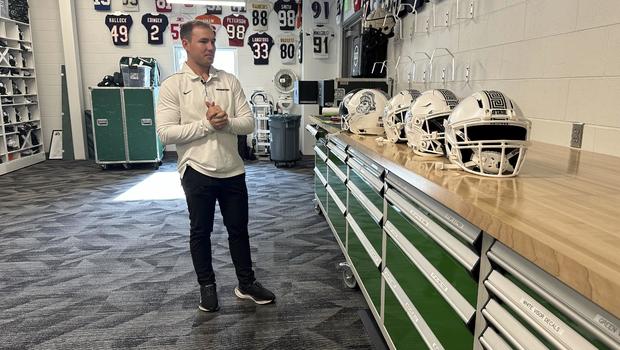It was not an unusual sight for Andrew Kolpacki. He used to watch NFL games on TV on Sundays, where tens of thousands of fans would yell at the top of their lungs as quarterbacks put their hands on their helmets in a frantic attempt to hear the play call from the sideline or booth.
Upon the approval of coach-to-player helmet communications in 2024 games by the NCAA’s playing rules oversight committee this past spring, Michigan State head football equipment manager Kolpacki understood the Spartans’ quarterbacks and linebackers would face a challenge.
“There had to be some sort of solution,” he stated.
There was, as it happens. It was also directly across the street.
Tamara Reid Bush, a professor of mechanical engineering who oversees the school’s Biomechanical Design Research Laboratory and has a football season ticket, was contacted by Kolpacki.
Joe Kolpacki “showed me some photos and said that other teams had just put duct tape inside the (earhole), and he asked me, ‘Do you think we can do anything better than duct tape,?” Bush stated. “And I said, ‘Oh, absolutely.'”
Bush and Rylie DuBois, an undergraduate research assistant at the lab and sophomore majoring in biosystems engineering, set out to use a 3D printer to create earhole inserts from polylactic acid, a bio-based plastic. Taking into consideration the different earhole shapes and sizes depending on the model of helmet was part of the problem.
The inserts helped reduce crowd noise when starting quarterback Aidan Chiles and linebacker Jordan Turner’s helmets were equipped with them after the season began on August 30 with a Friday night home game versus Florida Atlantic.
DuBois sat in the student section at the game.
“I felt such a strong sense of accomplishment and pride,” DuBois stated. “And I told all my friends around me about how I designed what they were wearing on the field.”
Due in part to the wide range of helmet styles and colors that Spartan players can wear on any given Saturday, Bush and DuBois have developed approximately 180 sets of the inserts overall. Additionally, during the season, the engineering team has been improving their design.
Similar actions are being taken by dozens more Bowl Subdivision institutions. XO Armor Technologies, which offers on-site, on-demand 3D printing of athletic wearables, is frequently the source of their 3D-printed earhole covers.
According to Jeff Klosterman, vice president of business development at XO Armor, the Auburn, Alabama-based company has given its version of the earhole covers to the equipment managers of programs from Georgia and Clemson to Boise State and Arizona State in the hopes that the universities will think about working with the company in the future.
At the close of the previous season, the Houston Texans contacted XO Armor about developing a device that would let quarterback C.J. Stroud hear play calls that were sent to his helmet during away games. After working on and finishing one option, XO Armor was contacted again by Ohio State, who had learned that Michigan State was proceeding with helmet inserts and wanted to know whether XO Armor had any other plans.
“We kind of just did this as a one-off favor to the Texans and honestly didn’t forecast it becoming our viral moment in college football,” Klosterman stated. “We’ve now got about 60 teams across college football and the NFL wearing our sound-deadening earhole covers every weekend.”
Only one player per team is allowed to communicate with coaches while on the field, according to the rules. Usually, Turner plays defense while Chiles plays offensive for the Spartans. Chiles has requested that the insert be placed in just one earhole on his helmet, but Turner would like it in both.
Chiles “likes to be able to feel like he has some sort of outward exposure,” Kolpacki said.
Exposure is something the sophomore signal-caller from Long Beach, California, had in away games against Michigan and Oregon this season. Michigan Stadium welcomed 110,000-plus fans for the Oct. 26 matchup between the in-state rivals. And while just under 60,000 packed Autzen Stadium in Eugene, Oregon, for the Ducks’ 31-10 win over Michigan State three weeks earlier, it was plenty loud. “The Big Ten has some pretty impressive venues,” Kolpacki said.
“It can be just deafening,” he said. “That’s what those fans are there for is to create havoc and make it difficult for coaches to get a play call off.”
Something that is a bit easier to handle thanks to Bush and her team. She called the inserts a “win-win-win” for everyone.
“It’s exciting for me to work with athletics and the football team,” she said. “I think it’s really exciting for our students as well to take what they’ve learned and develop and design something and see it being used and executed.”
Note: Every piece of content is rigorously reviewed by our team of experienced writers and editors to ensure its accuracy. Our writers use credible sources and adhere to strict fact-checking protocols to verify all claims and data before publication. If an error is identified, we promptly correct it and strive for transparency in all updates, feel free to reach out to us via email. We appreciate your trust and support!



Leave a Reply